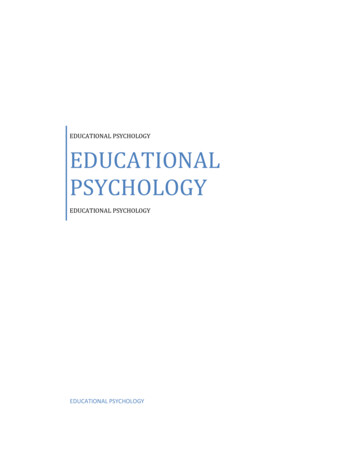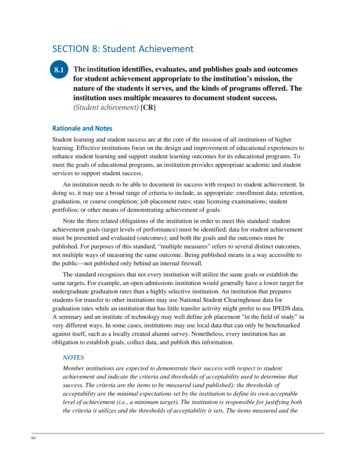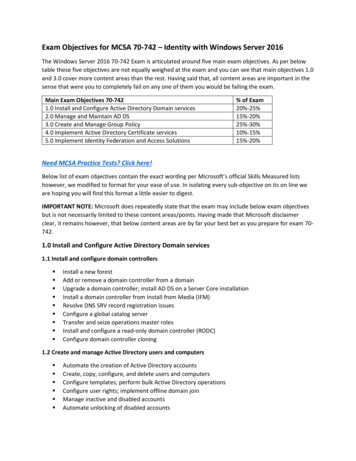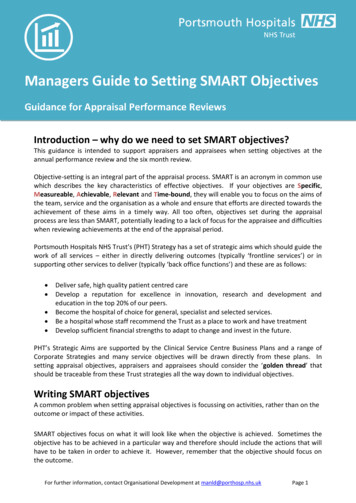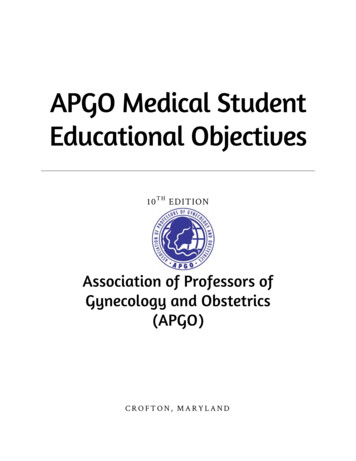
Transcription
APGO Medical StudentEducational Objectives10 T H EDITIONAssociation of Professors ofGynecology and Obstetrics(APGO)CROFTON, MARYLAND
This publication was revised by theAPGO Undergraduate MedicalEducation Committee (UMEC)2012-2014Nancy A. Hueppchen, MD, MSc, ChairJodi F. Abbott, MDSamantha D. Buery-Joyner, MDAlice W. Chuang, MDAmie J. Cullimore, BEd, MD, MScJohn L. Dalrymple, MDLorraine Dugoff, MDDavid A. Forstein, DOB. Star Hampton, MDSarah M. Page-Ramsey, MDArchana A. Pradhan, MDAbigail N. Wolf, MDJoseph M. Kaczmarczyk, DO, MPH (UMEC 2008-2013)Lead Editor: Alice W. Chuang, MDGlossary Editor: Archana A. Pradhan, MD, Abigail N.Wolf, MDTable Editors: Samantha D. Buery-Joyner MD; Amie J. Cullimore, BEd, MD, MScElectronic Resources Editor: John L. Dalrymple, MDHot Topics Editor: Sarah M. Page-Ramsey, MDOsteopathic Editor: David A. Forstein, DOCopy Editors: Donna D. Wachter, APGO Executive Director;Christy Carr, Michelle Kobryn, Petra Casey, MDCopyright 2014 by Association of Professors of Gynecology and Obstetrics (APGO).All rights reserved. Before beginning any projects and papers using APGO copyrighted materials and resources, pleasecontact the APGO office at apgoadmin@apgo.org in advance for permission. APGO must be acknowledged in theproject/paper. Faculty/residents/students/institutions may print the PDF for personal and general student use. Theonline PDF of the Objectives and the Teaching Cases may be photocopied for teaching purposes, but may not beretyped, altered or otherwise manipulated in any way. APGO must be acknowledged in all photocopied material.Association of Professors of Gynecology and Obstetrics (APGO)2130 Priest Bridge Drive, Suite 7Crofton, Maryland 21114www.apgo.orgBook Layout 2013 BookDesignTemplates.com
Table of ContentsUNIT 1: APPROACH TO THE PATIENT1. History . 12. Examination . 23. Pap Test and DNA Probes/Cultures . 34. Diagnosis and Management Plan . 45. Personal Interaction and Communication Skills . 56. Legal and Ethical Issues in Obstetrics and Gynecology. 67. Preventive Care and Health Maintenance. 7UNIT 2: OBSTETRICSSection A: Normal Obstetrics8. Maternal-Fetal Physiology . 99. Preconception Care . 1010. Antepartum Care . 1111. Intrapartum Care . 1212. Immediate Care of the Newborn. 1313. Postpartum Care . 1414. Lactation . 15Section B: Abnormal Obstetrics15. Ectopic Pregnancy. 1616. Spontaneous Abortion . 1717. Medical and Surgical Complications of Pregnancy . 1818. Preeclampsia-Eclampsia . 2019. Alloimmunization . 2120. Multifetal Gestation . 22
UNIT 2: OBSTETRICS (CONTINUED)21. Fetal Demise . 2322. Abnormal Labor. 2423. Third Trimester Bleeding . 2524. Preterm Labor . 2625. Premature Rupture of Membranes . 2726. Intrapartum Fetal Surveillance . 2827. Postpartum Hemorrhage. 2928. Postpartum Infection . 3029. Anxiety and Depression . 3130. Postterm Pregnancy . 3231. Fetal Growth Abnormalities . 33Section C: Procedures32. Obstetric Procedures . 34UNIT 3: GYNECOLOGYSection A: General Gynecology33. Family Planning . 3634. Pregnancy Termination . 3735. Vulvar and Vaginal Disease . 3836. Sexually Transmitted Infections (STI) and Urinary Tract Infections (UTI) . 3937. Pelvic Floor Disorders . 4038. Endometriosis . 4139. Chronic Pelvic Pain . 42Section B: Breast40. Disorders of the Breast . 43
UNIT 3: GYNECOLOGY (CONTINUED)Section C: Procedures41. Gynecologic Procedures . 44UNIT 4: REPRODUCTIVE ENDOCRINOLOGY, INFERTILITY AND RELATED TOPICS42. Puberty . 4643. Amenorrhea . 4744. Hirsutism and Virilization . 4845. Normal and Abnormal Uterine Bleeding . 4946. Dysmenorrhea . 5047. Menopause . 5148. Infertility . 5249. Premenstrual Syndrome (PMS) and Premenstrual Dysphoric Disorder (PMDD) . 53UNIT 5: NEOPLASIA50. Gestational Trophoblastic Neoplasia (GTN) . 5451. Vulvar Neoplasms . 5552. Cervical Disease and Neoplasia . 5653. Uterine Leiomyoma . 5754. Endometrial Hyperplasia and Carcinoma. 5855. Ovarian Neoplasms . 59UNIT 6: HUMAN SEXUALITY56. Sexuality and Modes of Sexual Expression. 60
UNIT 7: VIOLENCE AGAINST WOMEN57. Sexual Assault . 6158. Intimate Partner Violence. 62UNIT 8: OSTEOPATHY AND WOMEN'S HEALTH CARE59. Introduction to Osteopathic Principles in Obstetrics & Gynecology . 6460. Osteopathic History Taking. 6661. Osteopathic Structural Exam . 6762. Osteopathic Diagnosis and Management Plan . 6863. Osteopathy in Obstetrics . 6964. Osteopathy in Gynecology . 71GLOSSARY . 72OSTEOPATHIC TERMINOLOGY . 91
APGO MEDICAL STUDENT EDUCATIONAL OBJECTIVES, 10THEDITIONiINTRODUCTIONThe Undergraduate Medical Education Committee (UMEC) of the Association of Professors of Gynecology andObstetrics is pleased to present the 10th edition of the APGO Medical Student Educational Objectives. The Objectives arereviewed on a regular basis to ensure their relevance, importance and helpfulness in assisting with the development ofobstetrics and gynecology clinical clerkship curricula. A team of ob-gyn clerkship directors and medical educators fromthe U.S. and Canada had input into the current edition and its format with the goal of making these objectives as usefulas possible for clerkship directors, faculty and medical students. For the 10th edition, APGO members and medicalstudents were also surveyed to provide input on format and topics.Please note that the APGO Objectives are not meant to be a mandate; they define a central body of women’s healthknowledge, skills and attitudes that are fundamental to the practice of a general physician, and are intended to provideclerkship directors, faculty and students with a resource for curriculum development, teaching and learning. Thecurriculum content can be expanded or modified for institutions with longer or shorter clerkships.In this edition, we have added osteopathic objectives related to women’s health. We have also included mapping of theobjectives to APGO Electronic Resources and Hot Topics, such as advocacy, pharmacology, global health, ethics andmore.In order to maximize the usefulness of this document, the APGO Medical Student Educational Objectives areorganized in the following format: EDUCATIONAL OBJECTIVESEDUCATIONAL TOPIC AREASINTENDED LEARNING OUTCOMESEDUCATIONAL OBJECTIVESThe committee identified 18 broad Educational Objectives (Table 1) that include all 64 Educational Topic Areas. Thesebroad Educational Objectives are intended to be most useful to clerkship directors and can be used as a basis forclerkship curriculum and evaluation design. In addition, they can be used as the basis for creating a list of proceduresand patient diagnoses that students must see in order to meet the clerkship educational objectives (often referred to as“student logs”).EDUCATIONAL TOPIC AREASThe 64 Educational Topic Areas serve as a table of contents and are useful in organizing the curriculum for teachingand evaluation.A majority of the Educational Topic Areas have an associated Clinical Case (six osteopathic clinical cases are indevelopment). These cases are available on the APGO Web site and can be used for case-based learning sessions.Additionally, the APGO Undergraduate Web-Based Interactive Self-Evaluation (uWISE)* is a 542-question interactive
APGO MEDICAL STUDENT EDUCATIONAL OBJECTIVES, 10THEDITIONself-exam based on the educational topic areas that can be used for student self-assessment. uWISE is located on theAPGO Web site at https://www.apgo.org/student.html* uWISE requires an additional subscriptionINTENDED LEARNING OUTCOMESIntended Learning Outcomes define educational expectations for medical students. We recognize that curricula arediverse; therefore, educators are encouraged to consider where in their medical school curriculum to address theselearning outcomes.thWe expect that the changes in this 10 edition will make this resource more useful. We welcome yourfeedback about this edition and remain dedicated to meeting the needs of the APGO membership.ii
APGO MEDICAL STUDENT EDUCATIONAL OBJECTIVES, 10THEDITIONiiiTABLE 1. THE 18 EDUCATIONAL OBJECTIVES OF OB-GYN UNDERGRADUATE MEDICALEDUCATION AND RELATED EDUCATIONAL TOPIC AREASA student will be able to:Objective NumberObjective DescriptionRelated Educational Area Topic Number1Develop competence in the medical interview and physicalexamination of women, and incorporate ethical, social anddiversity perspectives to provide culturally competent healthcare.1, 2, 3, 4, 5, 59, 60, 61, 622Apply recommended prevention strategies to womenthroughout the lifespan.7, 57, 583Recognize his/her role as a leader and advocate for women.64Demonstrate knowledge of preconception care including theimpact of genetics, medical conditions and environmentalfactors on maternal health and fetal development.95Explain the normal physiologic changes of pregnancyincluding interpretation of common diagnostic studies.8, 10, 636Describe common problems in obstetrics.16, 17, 18, 19, 20, 21, 23, 29, 30, 31,637Demonstrate knowledge of intrapartum care of the motherand newborn.11, 22, 24, 25, 26, 32, 638Demonstrate knowledge of postpartum care.12, 13, 14, 27, 28, 639Describe menstrual cycle physiology, discuss puberty andmenopause and explain normal and abnormal bleeding.42, 43, 44, 45, 46, 47, 4910Describe the etiology and evaluation of infertility.4811Develop a thorough understanding of contraception,including sterilization and abortion.33, 3412Demonstrate knowledge of common benign gynecologicalconditions.35, 36, 37, 38, 5313Formulate a differential diagnosis of the acute abdomen andchronic pelvic pain.15, 39, 6414Describe common breast conditions and outline theevaluation of breast complaints.4015Demonstrate knowledge of perioperative care and familiaritywith gynecological procedures.41, 64
APGO MEDICAL STUDENT EDUCATIONAL OBJECTIVES, 1016Describe gynecological malignancies including risk factors,signs and symptoms and initial evaluation.50, 51, 52, 54, 5517Provide a preliminary assessment of patients with sexual concerns.5618Understand the basic tenets and fundamental techniques utilizedto evaluate, diagnose and treat the female patient osteopathically.59, 60, 61, 62, 63, 64THEDITIONiv
APGO MEDICAL STUDENT EDUCATIONAL OBJECTIVES, 10THEDITIONvKEYLevels of Competence*K KnowsKH Knows HowSH Shows HowD Does*As defined by Miller GE in The assessment of clinical skills/competence/performance. Acad Med 1990;65:S63-7.Instructional MethodsCBL Case-Based LearningCE Clinical ExperienceI L Independent LearningL LectureRP Role Play/DramatizationS SimulationAssessment MethodsCDR Clinical Documentation ReviewCK Clinical Performance Ratings/ChecklistMCQ* Exam – Institutionally developed or nationally normed/standardized, subjectOSCE** Exam – Institutionally developed, clinical performanceOE Exam – Institutionally developed, oral*MCQ multiple choice question examination**OSCE objective structured clinical examinationThe suggested instructional methods and assessment methods above were extracted from the Association of American Medical Colleges(AAMC) Curriculum Inventory.* The list is not comprehensive but provides commonly used suggested urriculumreports/Hot TopicsA AdvocacyE EthicsGE GeneticsGH Global HealthIP Interprofessional EducationN NutritionPH PharmacologyPM Pain ManagementPS Patient SafetyS Surgical SkillsAPGO Electronic ResourcesBCS – Basic Clinical Skills CurriculumEP – Effective Preceptor SeriesES – Educational SeriesOTC – Online Teaching CasesuW – uWISEWWD – Women with Disabilities
APGO MEDICAL STUDENT EDUCATIONAL OBJECTIVES, 10THEDITIONACGME OUTCOME PROJECT GENERAL COMPETENCIESThe residency program must integrate the following ACGME competencies into the curriculum:A. Patient CareResidents must be able to provide patient care that is compassionate, appropriate, andeffective for the treatment of health problems and the promotion of health.B. Medical KnowledgeResidents must demonstrate knowledge of established and evolving biomedical,clinical, epidemiological and social-behavioral sciences as well as the application of thisknowledge to patient care.C. Practice-Based Learning and ImprovementResidents must demonstrate the ability to investigate and evaluate their care ofpatients, to appraise and assimilate scientific evidence, and continuously improvepatient care based on constant self-evaluation and life-long learning.D. Interpersonal and Communication SkillsResidents must demonstrate interpersonal and communication skills that result inthe effective exchange of information and collaborations with patients, their families,and other health professionals.E. ProfessionalismResidents must demonstrate a commitment toresponsibilities and an adherence to ethical principles.carryingout professionalF. Systems-Based PracticeResidents must demonstrate an awareness of and responsiveness to the larger contextand system of health care, as well as the ability call on other resources in the system toprovide optimal health care.vi
APGO MEDICAL STUDENT EDUCATIONAL OBJECTIVES, 10THEDITIONviiINTRODUCTION TO OSTEOPATHIC MEDICINE – UNIT 8 (EDUCATIONAL TOPICS 59-64)This unit has been written to provide the physician preceptor (osteopathic or allopathic) and the third-year medicalstudent (osteopathic or allopathic) an understanding of the basic tenets of osteopathy and how these principles can beintegrated into the practice of obstetrics and gynecology to care for women of all ages. The forefather of osteopathicmedicine was Andrew Taylor Still, MD, DO, who established the first osteopathic medical school in 1892 in Kirksville,Missouri. Doctor Still’s fundamental beliefs upon which he established osteopathy were based on four underlyingprinciples:(1) The body is a unit with component parts that work synergistically to benefit the whole organism. Theperson is a unit of body, mind and spirit.(2) The body is capable of self-regulation, self-healing, and health promotion. The body has an inherentcapability to support and heal itself.(3) The structure and function of the body are reciprocally interrelated.(4) Rational treatment is based on a complete understanding of the principles of body unity, self-regulation,and the interrelationship of structure and function.Since osteopathy began in 1892, Osteopathic Principles and Practice guidelines have helped both the patient andphysician alike. Osteopathic physicians utilize the fundamental belief in the “cause and effect” relationship. The patientpresents with a symptom or dysfunction (effect) and the physician works towards finding the reason for the symptomor diagnosis (cause). Inherent to this philosophy is the concept of somatic dysfunction, which is unique to osteopathicmedicine. Somatic dysfunction is the lack of, or impaired function of, normal anatomy and/or related components ofthe soma (body). Given that the body is composed of musculoskeletal, circulatory, lymphatic, and neural componentswhich all work as a whole in the function of the patient’s status, a somatic dysfunction is a change in the normalfunction of any of these areas. When properly evaluated and diagnosed, this dysfunction can be treated and homeostasiscan be restored using osteopathic manipulative treatment, the definitive treatment of somatic dysfunction. With thisapproach, physicians have learned to evaluate patients differently and to “think osteopathically” with their hands inorder to diagnose and treat the whole patient, restoring health to the body, the mind, and spirit.The objective of this unit is to assemble a collection of various osteopathic concepts and techniques into one basicreference for the physician preceptor (both DO and MD) and for the third-year osteopathic medical student. Thischapter is not intended to be all-inclusive but to provide general guidelines to understand the basic tenets andfundamental techniques utilized to evaluate, diagnose and treat the female patient osteopathically. Our goal is to fosteran appreciation of the fundamentals of Osteopathic Principles and Philosophy (OPP) and the practice of OsteopathicManipulative Medicine (OMM).
APGO MEDICAL STUDENT EDUCATIONAL OBJECTIVES, 10THEDITION1U N I T 1: A P P R O A C H T O T H E P A T I E N TEducational Topic 1: HistoryRationale: A gynecological evaluation is an important part of primary health care and preventive medicine forwomen. A gynecological assessment should be a part of every woman’s general medical interview and physicalexamination. Certain questions must be asked of every woman, whereas other questions are specific toparticular problems. To accomplish these objectives, optimal communication must be achieved betweenpatient and physician.A student should be able to:Intended Learning OutcomesA. Complete a comprehensivewomen’s medical interview, including:1. Menstrual history2. Obstetric history3. Gynecologic history4. Contraceptive history5. Sexual history6. Family/genetic history7. Social historyB. Assess risk for unintended pregnancy,sexually transmitted infections, cervicalpathology, breast malignancy, gynecologicmalignancies, nutrition/obesity, domesticviolence and eating disordersC. Assess the patient’s adherence to therecommended screening measuresD. Demonstrate interpersonal andcommunication skills that build trustby addressing relevant factorsincluding culture, ethnicity, language/literacy, socioeconomic status,spirituality/religion, age, sexualorientation and disabilityE. Produce well-organized written andoral reports to communicate the resultsof the ob-gyn and general medicalinterviewLevel MECompetencyHot TopicsDCBL, CE,IL, L, RP,SCDR, CKA, B, D, EGESHCBL, CE,IL, L, RP, SCDR, CK,OSCEA, B, D, EA, N, PSDCBL, CE,IL, L, RP, SCBL, CE,IL, L, RP, SCDR, CKA, B, DACDR, CK,OSCEA, D, EA, GHCBL, CE,IL, L, RP, SCDR, CKA, B, DSHDAPGOeResourcesEP, ES,WWD
APGO MEDICAL STUDENT EDUCATIONAL OBJECTIVES, 10THEDITION2U N I T 1: A P P R O A C H T O T H E P A T I E N TEducational Topic 2: ExaminationRationale: An accurate examination complements the history, provides additional information, helpsdetermine diagnosis and guides management. It also provides an opportunity to educate and reassure thepatient.A student should be able to:Intended Learning OutcomesA. Demonstrate interactions with thepatient that gains her confidence andcooperation and assures her comfortand dignityB. Perform accurate examinations in asensitive manner, including:1. Breast examination2. Abdominal examination3. Complete pelvic examinationC. Describe the:1. Normal female anatomyacross the life span2. Appearance of commonpathology of the femaleurogenital tract3. Appearance of common breastchanges and disordersD. Produce well-organizedwritten and oral reports tocommunicate findings of theexaminationE. Communicate examination findingswith the patient as appropriateLevel MECompetencyDCBL, CE,RP, SCDR, CKA, D, E, FDCBL, CE,IL, L, RP, SCDR, CKA, B, D, EKHCBL, CE,IL, LMCQ, OEA, B, DDCBL, CE,IL, L, RP, SCDR, CKA, B, DDCBL, CE,IL, L, RP, SCDR, CKA, B, D, EHot TopicsAAPGOeResourcesBCS, EP
APGO MEDICAL STUDENT EDUCATIONAL OBJECTIVES, 10THEDITION3U N I T 1: A P P R O A C H T O T H E P A T I E N TEducational Topic 3: Pap Test and DNAProbes/CulturesRationale: The Pap Test is one of the most effective screening tests used in medicine today. Proper techniquein performing the Pap Test and obtaining specimens for DNA probes and/or microbiologic culture willimprove accuracy.A student should be able to:Intended Learning OutcomesLevel ofCompetenceInstructionalMethodA. Perform a Pap TestDB. Obtain specimens to detect sexuallytransmitted infectionsC. Explain the purpose of these tests tothe patientDCBL, CE,IL, L, RP, SCBL, CE,IL, L, RP, SCBL, CE,IL, L, RP, SSHAssessmentMethodACGMECompetencyCDR, CKA, B, D, ECDR, CKA, B, D, ECDR, CK,OSCEA, B, D, EHot TopicsAPGOeResourcesBCS, ES,OTC, uW
APGO MEDICAL STUDENT EDUCATIONAL OBJECTIVES, 10THEDITION4U N I T 1: A P P R O A C H T O T H E P A T I E N TEducational Topic 4:Diagnosis and Management PlanRationale: Accurately identifying problems and selecting the most likely diagnoses lead to effectivemanagement plans.A student should be able to:Intended Learning OutcomeLevel ofCompetenceInstructionalMethodA. Generate a problem listDCBL, CE,IL, L, RP, SCDR, CKA, BB. Formulate a diagnostic impression,including differential diagnosisDCBL, CE,IL, L, RP, SCDR, CKA, BC. Appraise cultural, psychosocial,economic and ethical issues in patientcareD. Develop a management plan thatincludes:1. Laboratory and diagnosticstudies2. Treatment options, bothmedical and surgical3. Patient education4. Continuing care plans5. Consideration for evidencebased medicineSHCBL, CE,RP, SCDR, CK,OSCEA, D, E, FA, E, GHDCBL, CE,IL, L, RP, SCDR, CKA, B, C, D,E, FPHAssessmentMethodACGMECompetencyHot TopicsAPGOeResourcesEP
APGO MEDICAL STUDENT EDUCATIONAL OBJECTIVES, 10THEDITION5U N I T 1: A P P R O A C H T O T H E P A T I E N TEducational Topic 5: Personal Interactionand Communication SkillsRationale: The student must interact and communicate effectively with a patient, her family, and all membersof a health care team.A student should be able to:Intended Learning OutcomesA. Develop rapport with patients,taking into account patients’ social andcultural contextsB. Work cooperatively with patients,their social supports and other membersof the health care teamC. Analyze his/her own strengths withregard to interaction and communicationskillsLevel MECompetencyHot TopicsDCBL, CE,RP, SCKA, D, E, FA, GHDCBL, CE,RP, SCKA, D, E, FA, IPEDCBL, CE,RP, SCKC, DIPEAPGOeResourcesEP, WWD
APGO MEDICAL STUDENT EDUCATIONAL OBJECTIVES, 10THEDITION6U N I T 1: A P P R O A C H T O T H E P A T I E N TEducational Topic 6: Legal and EthicalIssues in Obstetrics and GynecologyRationale: Recognizing and understanding the basis of legal and ethical issues in obstetrics and gynecology willpromote quality patient care and patient safety.A student should be able to:Intended Learning OutcomesLevel MECompetencyHot TopicsAPGOeResourcesA. Explain the following legal/ethical issues:1.Informed consentKHCBL, CE,IL, L, RP, SOSCE, OEA, B, D, E,FA, PS2.ConfidentialityDCBL, CE,RP, SCDR, CKA, D, EA, E3.Advance directives forhealthcareKHCBL, CE,IL, L, RP, SOSCE, OEA, B, D, E,FA, EScreening and reporting ofsuspected child abuse, sexualabuse and intimate partnerviolenceB. Discuss the legal and ethical issues inthe care of minorsC. Apply a systematic approach to ethicaldilemmas based on ethical principlesKHCBL, CE,IL, L, RP, SOSCE, OEA, B, D, E,FA, PSKHCBL, CE,IL, L, RP, SCBL, CE,IL, L, RP, SOSCE, OEA, B, D, E,FA, B, D, E,FA, ED. Describe issues of justice relating toaccess to obstetric-gynecology careKHCBL, CE,IL, L, RP, SOSCE, OEA, B, D, E,FA, EE. Recognize his/her role as a leader andadvocate for womenKHCBL, CE,IL, L, RP, SOSCE, OEA, B, D, E,FAF. Recognize the ethical issues of otherspecialties and disciplines as they relateto women’s healthcareKHCBL, CE,IL, L, RP, SOSCE, OEA, B, D, E,FE, IPE4.KHOSCE, OEEEP, OTC,uW,WWD
APGO MEDICAL STUDENT EDUCATIONAL OBJECTIVES, 10THEDITION7U N I T 1: A P P R O A C H T O T H E P A T I E N TEducational Topic 7: Preventive Care andHealth MaintenanceRationale: The student will recognize the value of ro
Obstetrics is pleased to present the 10th edition of the APGO Medical Student Educational Objectives. The Objectives are reviewed on a regular basis to ensure their relevance, importan
